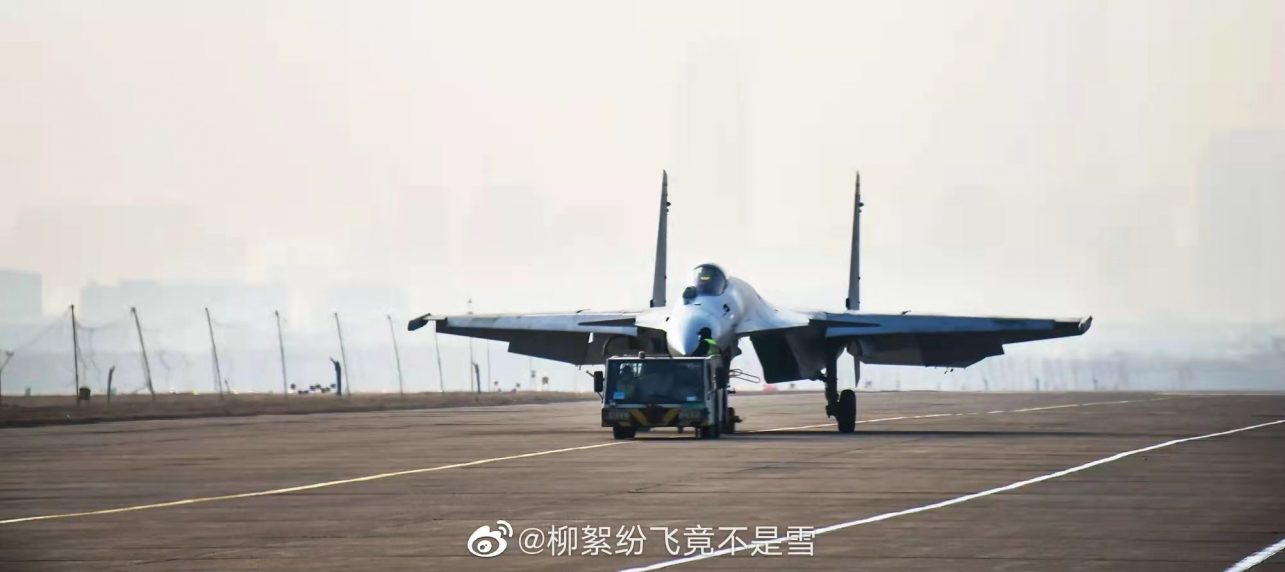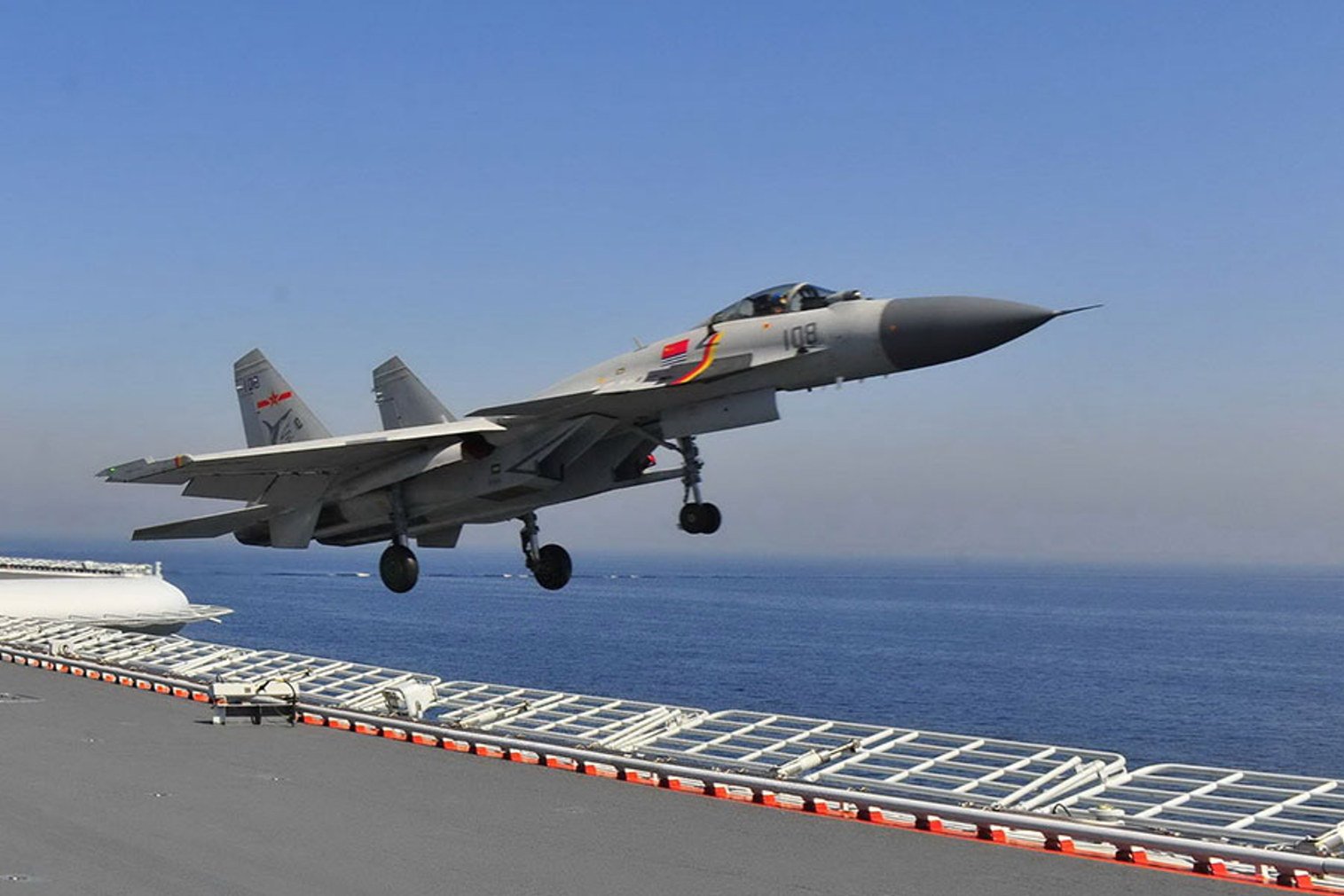China’s J-15 ‘Flying Shark’ has started to hog the media limelight as PLA Navy prepares for global challenges and confrontations. China’s sea-based capability is expected to enhance significantly as its first-ever carrier-borne fighter jet, J-15 ‘Flying Shark’ appears in a new and improved avatar.
China recently unveiled an enhanced version of its J-15 ship-borne fighter jet that has just completed test flights, with sources claiming that the new aircraft’s missile pylons, infrared search and track system, radar, and wings have all been upgraded, reported the Global Times.
Experts said on December 16 that the modified J-15, which could potentially operate with catapults, will play a major role on both China’s old as well as new aircraft carriers.
A catapult is a device that allows aircraft to take off from a small area, such as the deck of a ship, although it can also be used to create land-based runways in exceptional situations. It is an assistance-based takeoff. This gives the Chinese carrier-borne fighters more teeth in terms of operational and combat compatibility.
China has two existing carriers, the Liaoning and the Shandong with the third Type 003 speculated to be launched early next year.
The upgrades to J-15 could be part of its plan to make these carrier-based fighters compatible with the third aircraft carrier that is believed to have the Electromagnetic Aircraft Launch System or EMALS.
New J-15 carrier-borne aircraft, without pitot tube, guess installed AESA radar and electronic system is same as J-16. Unfortunately, the most important aircraft front wheel can not see, don't know if it is J-15T catapult-version. ?
(Image via wb/柳絮纷飞竟不是雪) pic.twitter.com/APuBg0Ecez— 彩云香江 (@louischeung_hk) December 14, 2021
Shenyang Aircraft Corporation, a subsidiary of China’s state-owned Aviation Industry Corp, posted photos of production activities on its social media account earlier this week. The media and netizens were particularly drawn to one of the photographs, which showed a J-15 fighter jet taxiing on a runway with the help of a tug truck.
The new J-15 looks significantly different from prior models, indicating that it is an updated version, Eastday.com, a Shanghai-based news website was quoted as saying by the state-owned Global Times.
The ‘Upgraded’ J-15 Flying Shark
According to the photos that were released, the new J-15 Flying Shark could be seen as employing a new type of wingtip pylon, similar to the J-16 fighter jet, potentially in a bid to replace the older version traditionally used on the aging J-11B.
The new one can carry China’s most advanced short-range combat missile, the PL-10, whereas the previous version could only carry the older PL-8. The PL-10 is much deadlier than the PL-8, as it can be launched as soon as the pilot locates the target and is extremely difficult to evade, thanks to its extreme maneuverability and advanced infrared guidance.

This enhanced capacity to carry more advanced missiles will make the existing J-15 more agile and lethal and more prepared to face challenges in the South China Sea, the theatre of conflict with its East-Asian neighbors and the United States. The Indo-Pacific region remains volatile and China’s J-15 upgrade is in consonance with its ambitions to retain its superiority in the region.
According to eastday.com, the photo shows that the infrared search and track systems in front of the cockpit and in front of the wings have been altered, indicating that the new J-15’s avionics systems have also been enhanced.
Another significant difference is the radar, as the new radome’s lightning diverter stripes are not the same as the old one.
Shenyang produces first catapult-capable J-15
Now has completed the production of its first catapult-capable variant of the J-15 carrier-borne multirole fighter aircraft, according to images released by AVIC. pic.twitter.com/pAmdGTLl2e— MPCohen Fractional Orbital Ballistic Tweets (@mpceddington) December 16, 2021
This could suggest that the upgraded J-15 has switched to a more modern, active electronically scanned array radar system (AESA) which in turn will allow it to use the most advanced PL-15 beyond visual range (BVR) air-to-air missile. China is among the few countries that possess AESA technology.
An unnamed Chinese military specialist told Global Times that the latest variant of J-15 appears to be a fourth-generation-plus fighter jet. If confirmed, this would mean that China will now be in possession of an intermediary aircraft after its fourth-generation fighters and its new 5th generation J-20s.
The updated J-15 could potentially make the fleet stronger and more advanced by working as a force multiplier.

Both China’s previous aircraft carriers, which use ski-jump ramps, and the future Type 003, which would have catapults, will potentially operate the new J-15. The fighter jet will function in tandem with China’s future fifth-generation carrier-based fighter jet and early warning aircraft in both assault and air-to-air combat, according to experts.
In a separate post published on December 15, Shenyang Aircraft Corp. stated that as of that day, it had finished all manufacturing and test flights for 2021 and that it had reached new highs in terms of building and delivering aircraft.
This could be perceived as a subtle indication that the upgraded aircraft are running in tandem with the schedule of the new carrier launch.
J-15 – Big Boost For PLA Navy
The Shenyang J-15, also known as the Flying Shark, is a Chinese all-weather, twinjet, carrier-based 4th-generation multi-role carrier-borne fighter aircraft developed for the People’s Liberation Army Naval Air Force.
The J-15 is 22.28 meters long, 15 meters wide, 5.92 meters tall, and has a maximum takeoff weight of 32500 kilograms. The jet has a top speed of 2.4 Mach, a range of 3,500 kilometers, and a service ceiling of 20,000 meters, thanks to two Saturn AL-31 turbofan engines.

Its development, however, was fraught with controversy. Russia had earlier alleged that China had violated intellectual property agreements by developing its own version of the Su-33 Flankers. This event had eventually ended Chinese negotiations with Russia for new military planes in 2006.
According to the Flying Shark’s principal designer, this aircraft competes with the Sukhoi-33, the Eurofighter Typhoon, the Boeing F/A-18E Super Hornet, and other carrier-based aircraft in its class.
Now with new upgrades and enhanced capability, the J-15 could have assumed a more superior role in this class of aircraft and might aggressively be promoted by China on those lines when the roll-out is complete.
- Contact the author at sakshi.tiwari9555@gmail.com
- Follow EurAsian Times on Google News




